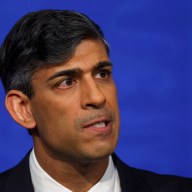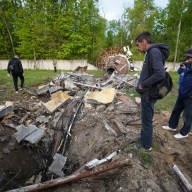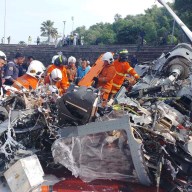LONDON – It was the secret subterranean command centre where Britain’s inspirational, cigar-chomping, wartime leader Winston Churchill plotted the downfall of Nazi Germany and sheltered from enemy air raids during the infamous Blitz on London.
But the labryinth-like network of underground bunkers in the shadow of Big Ben and Parliament reverberated Thursday with the sounds of clinking of tea cups and laughter as surviving staff – from intelligence officers to typists – gathered in the Cabinet War Rooms to recall life in the clandestine base ahead of the anniversary of the outbreak of World War II on Sept. 1, 1939.
“I don’t know quite how we did it. The whole thing about working underground, it’s very strange, really, because not only do you never see daylight but you also never have fresh air. I won’t say it was very pleasant,” said Joy Hunter, an 83-year-old former typist.
Hunter and the other veterans recalled the clatter of typewriters, the drone of air raid sirens and the thick clouds of smoke – most from cigarettes, but some from Churchill’s ubiquitous Havana cigars. Ministers, officers and young female staff mingled along corridors choked with stale air.
She remembers typing order papers for the D-Day landings – one of the key operations planned in the bunker – while working underground. The staff who used the bunker would dash there for protection as sirens sounded an air raid on London, spending hours at a time working in cramped rooms or sleeping in damp dormitories buried deep under Britain’s Treasury.
Churchill was often not there. The iconic leader who became Britain’s prime minister in 1940, was rarely at ease underground and commonly climbed atop the Treasury building’s roof to watch the German bombers’ sorties, rather than take shelter in the bunker.
Though the complex included a dining room adorned with artwork, swank bedrooms for Churchill and his wife Clementine, and the country’s only trans-Atlantic telephone line to U.S. President Franklin D. Roosevelt, the British leader was distinctly unimpressed with his bolthole.
“He didn’t like it at all, he thought he was a rat in a hole. He just didn’t like being confined in the small area and preferred to be over the road in Downing Street,” said Richard Langworth, a Churchill historian from Moultonborough, N.H, and author of “Churchill by Himself.”
Langworth said Churchill’s trans-Atlantic phone needed regular repair because the frustrated British leader would often bang the handset against a desk as he struggled to hear his American ally.
Historians say Churchill was determined to lead Britain’s war from central London, to show solidarity with those braving the Blitz and send an important signal of defiance to Hitler’s Germany. The leader shunned suggestions that he should relocate to a quiet city suburb.
“He was unique among 20th century British leaders, in that he saw himself as a warrior,” said Gary Sheffield, war studies professor at the University of Birmingham. “It’s reflected in his decision to remain in central London, despite the heavy bombing.”
Despite Churchill’s reservations, the Cabinet War Rooms became one of the key locations in World War II, Sheffield said.
In the centre’s Map Room, colour coded telephones brought news from fronts on multiple continents, while officers used drawing pins and spools of wool to chart out troop movements across maps pinned to the bunker’s dank walls.
The pins (red for British forces, purple for German), once overflowing ashtrays and piles of now yellowed documents have remained almost untouched since the bunker was closed down in 1945.
“The site was pretty well left as you see it, and left in aspic until the government designated it as a museum in 1948,” said Phil Reed, director of the Cabinet War Rooms.
Myra Collyer, a sprightly 85-year-old who recalls her days underground with a mischievous grin, has returned 11 times to show family and friends her wartime workplace.
“I’ll be honest with you, I joined the WAAF (the Women’s Auxiliary Air Force) to see the pilots – I married one in the end – but I was posted here,” said Collyer, who worked as a typist and later, an assistant to the site’s draftsmen. “It was called secret work, and I enjoyed it.”
Fellow veteran Joan Mynott, 89, says there was a sometimes flirtatious atmosphere between female recruits and military officers as they helped each other cope with the rigours of war and life underground – “as we used to say, a ‘nod and a wink’,” she said.
Collyer remembers rare evenings spent in London’s theatres and nightclubs, “mind you we weren’t clubbing like they do today,” she said, and winning free train rides by smiling at railway guards at the city’s Victoria station.
While staff remember their time in the bunker with fondness, a letter put on display for the first time reveals that the shelter would never have protected them from a direct hit from a Nazi bomb. The correspondence shows that Churchill was enraged when he was informed by staff.
“The P.M. said that I had ‘sold him a pup’ in letting him think that this place is a real bombproof shelter, whereas it is nothing of the kind,” senior civil servant Patrick Duff wrote to a colleague in 1940. “The place is not, and cannot be made, bomb proof in any sense.”
But Hunter said the prospect of a bomb strike rarely troubled those working in the bunker. “You didn’t about it when you were working. It was war, and nobody was really safe were they,” she said.
Others had different misgivings. Field Marshal Sir Alan Brooke, chief of the Imperial General Staff said the bunker “was in every way an excellent battle headquarters, with only one fault, namely its’ proximity to Winston,” alluding to Churchill’s reputed impatience with his staff.
















